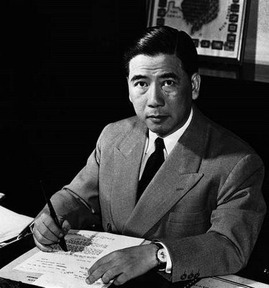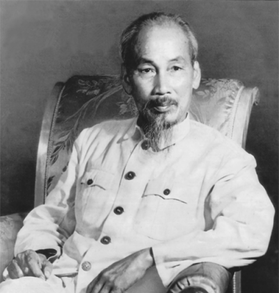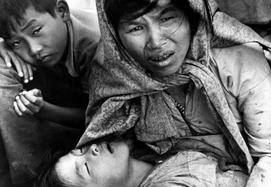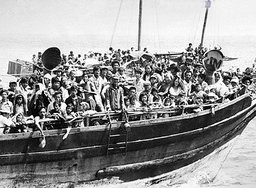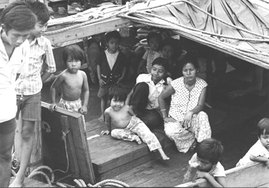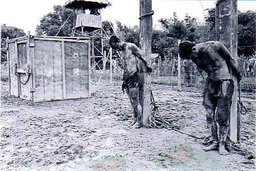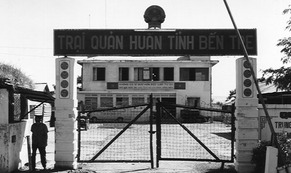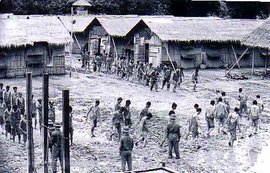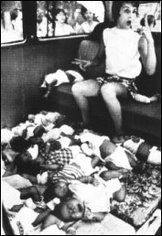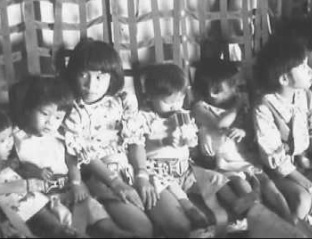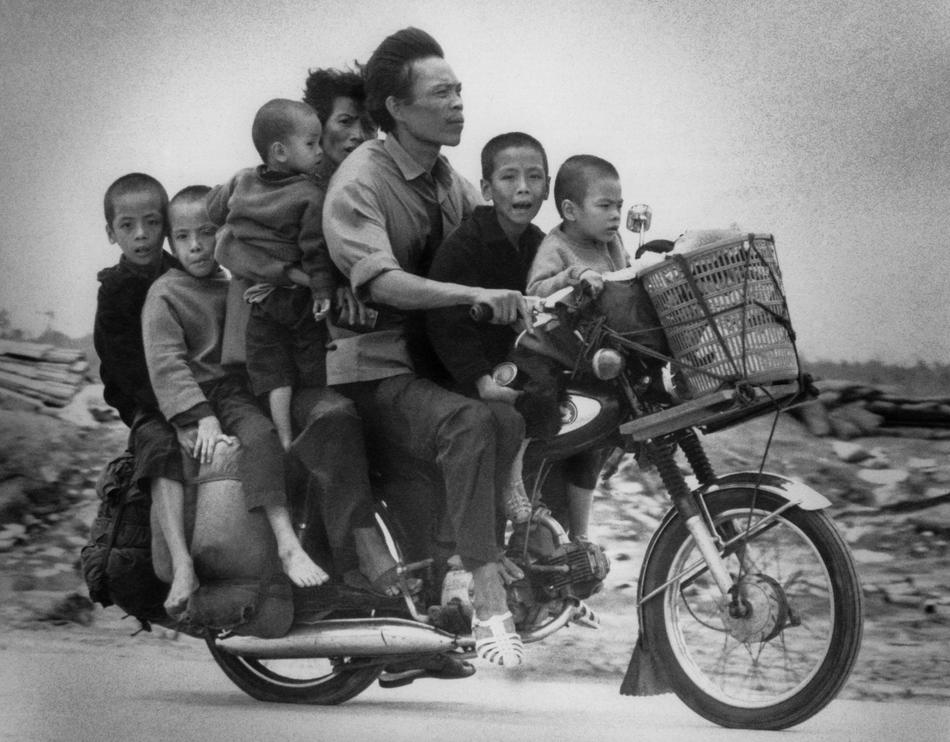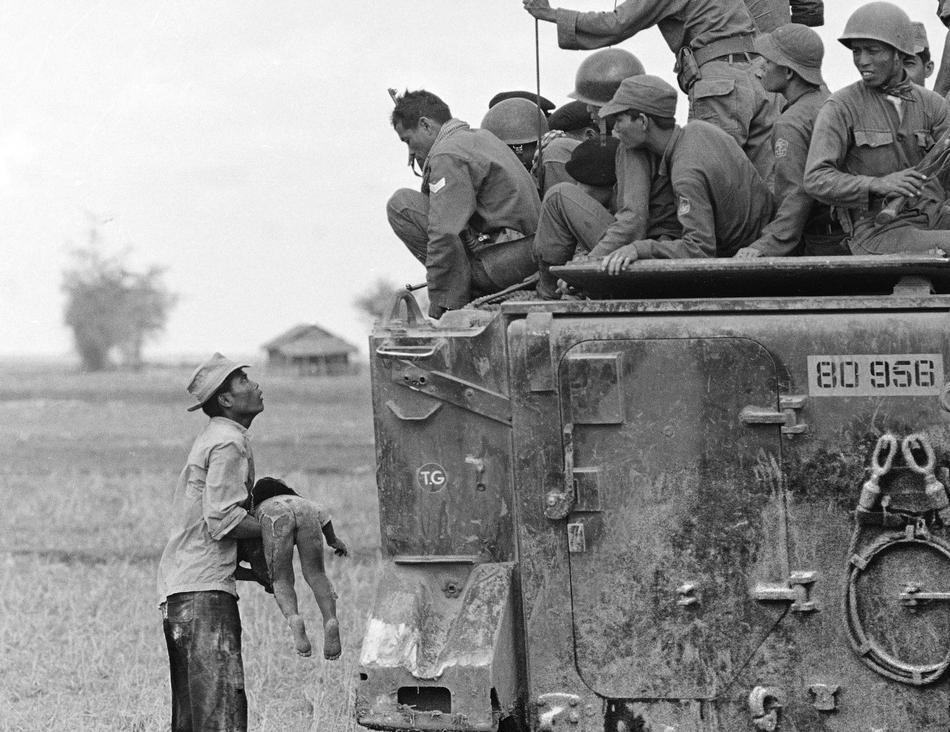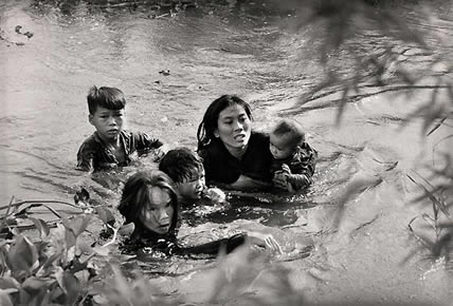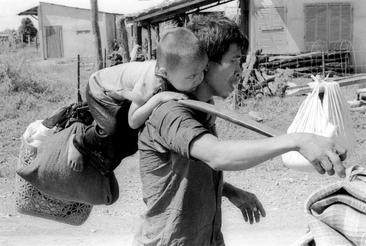THE VIETNAM CONFLICT
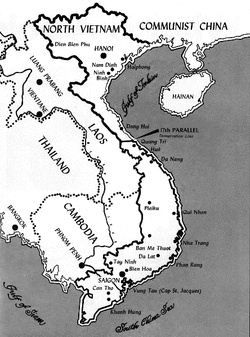
Project By: Cassidy Mullis & Margery Adams
AN INTRODUCTION TO VIETNAM
LOCATION: Vietnam is located on Indochina Peninsula in Southeast Asia. It is bordered by the countries: China, Laos, and Cambodia with the Eastern Sea bordering the largest area. It was originally divided into North Vietnam and South Vietnam, but is now unified and referred to as "The Socialist Republic of Vietnam".
TYPOGRAPHY: There is a great diversity of land characteristics ranging from hills, mountains, dense jungles, long coastlines, flat-lands and deltas. The deltas or flat wet areas with rich sediment make up the majority of the land. The climate is tropical (Vietnam Embassy).
PEOPLE: In 2009, the population totaled 85,789,573. Vietnam is very ethnically diverse, consisting of 54 ethnic groups. The major ethnic group, the Kinh people make up an overwhelming majority of 86% of the total population (Vietnam Embassy).
LANGUAGE: The Official language is Vietnamese (Vietnam Embassy)
MAJOR EXPORTS: Rice (and apparently people...)
LOCATION: Vietnam is located on Indochina Peninsula in Southeast Asia. It is bordered by the countries: China, Laos, and Cambodia with the Eastern Sea bordering the largest area. It was originally divided into North Vietnam and South Vietnam, but is now unified and referred to as "The Socialist Republic of Vietnam".
TYPOGRAPHY: There is a great diversity of land characteristics ranging from hills, mountains, dense jungles, long coastlines, flat-lands and deltas. The deltas or flat wet areas with rich sediment make up the majority of the land. The climate is tropical (Vietnam Embassy).
PEOPLE: In 2009, the population totaled 85,789,573. Vietnam is very ethnically diverse, consisting of 54 ethnic groups. The major ethnic group, the Kinh people make up an overwhelming majority of 86% of the total population (Vietnam Embassy).
LANGUAGE: The Official language is Vietnamese (Vietnam Embassy)
MAJOR EXPORTS: Rice (and apparently people...)
TIMELINE OF EVENTS
August 6, 1945- America drops bomb on Hiroshima
August 9, 1945- American drops bomb on Nagasaki
1954- Vietnam War begins after the rise of Ho Chi Minh to power and his communist Viet Minh party
1955- Dwight Eisenhower pledges support to Diem and South Vietnam
March 1965- Sent US combat forces into battle in Vietnam.
June 1965- 82,000 combat troops were stationed in Vietnam, and we were calling for 175,000 more by the end of 1965 to shore up the struggling South Vietnamese army.
November 1967- number of American troops in Vietnam was approaching 500,000 and US causalities had reached 15,058 killed and 109,527 wounded.
March 1968- US troops massacre more than 400 unarmed civilians in the village of My Lai
1973- The US negotiate a treaty with North Vietnamese, withdraw combat troopes and declare vietnamization complete.
1975- Communist forces seized control of Saigon, ending the Vietnam War
1976- Country becomes unified as the Socialist Republic of Vietnam
August 9, 1945- American drops bomb on Nagasaki
1954- Vietnam War begins after the rise of Ho Chi Minh to power and his communist Viet Minh party
1955- Dwight Eisenhower pledges support to Diem and South Vietnam
March 1965- Sent US combat forces into battle in Vietnam.
June 1965- 82,000 combat troops were stationed in Vietnam, and we were calling for 175,000 more by the end of 1965 to shore up the struggling South Vietnamese army.
November 1967- number of American troops in Vietnam was approaching 500,000 and US causalities had reached 15,058 killed and 109,527 wounded.
March 1968- US troops massacre more than 400 unarmed civilians in the village of My Lai
1973- The US negotiate a treaty with North Vietnamese, withdraw combat troopes and declare vietnamization complete.
1975- Communist forces seized control of Saigon, ending the Vietnam War
1976- Country becomes unified as the Socialist Republic of Vietnam
PRE-CONFLICT LIFE
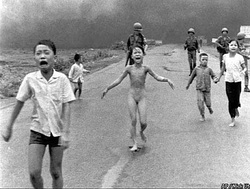
There had been fighting in Vietnam for decades before the Vietnam War began. The Vietnamese had suffered under French colonial rule for nearly six decades when Japan invaded portions of Vietnam in 1940. It was in 1941, when Vietnam had two foreign powers occupying them, that communist Vietnamese revolutionary leader Ho Chi Minh arrived back in Vietnam after spending thirty years traveling the world. Once Ho was back in Vietnam, he established a headquarters in a cave in northern Vietnam and established the Viet Minh, whose goal was to rid Vietnam of the French and Japanese occupiers. Having gained support for their cause in northern Vietnam, the Viet Minh announced the establishment of an independent Vietnam with a new government called the Democratic Republic of Vietnam on September 2, 1945. The French, however, were not willing to give up their colony so easily and fought back. For years, Ho had tried to court the United States to support him against the French, including supplying the U.S. with military intelligence about the Japanese during World War II. Despite this aid, the United States was fully dedicated to their Cold War foreign policy of containment, which meant preventing the spread of Communism. This fear of the spread of Communism was heightened by the U.S. "domino theory," which stated that if one country in Southeast Asia fell to Communism then surrounding countries would also soon fall. To help prevent Vietnam from becoming a communist country, the U.S. decided to help France defeat Ho and his revolutionaries by sending the French military aid in 1950. In 1954, after suffering a decisive defeat at Dien Bien Phu, the French decided to pull out of Vietnam. At the Geneva Conference of 1954, a number of nations met to determine how the French could peacefully withdraw. The agreement that came out of the conference (called the Geneva Accords) stipulated a cease fire for the peaceful withdrawal of French forces and the temporary division of Vietnam along the 17th parallel (which split the country into communist North Vietnam and non-communist South Vietnam).
WHAT LED TO CONFLICT
The Vietnam War is a story about South Vietnam's struggle for stability. By the end of the war, South Vietnam ended up being completely dependent on the US for its very life as a nation. Vietnam gained its independence from France in 1954, and the country was now divided into North and South Vietnam. The North had a communist government led by Ho Chi Minh. The South had an anti- communist government led by Ngo Dinh Diem. South Vietnam faced a serious threat: a communist-led revolutionary take-over. Preventing South Vietnam from falling to the communists, The United States were forced to intervene and fight a major regional war in Southeast Asia.
LIFE DURING THE CONFLICT
"The Boat People"
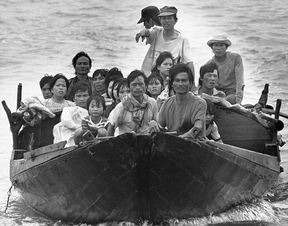
Since the Fall of Saigon, more than 575,000 Vietnamese have fled by sea. These refugees are known as “Boat People” (Hoi). These people desperately sought safety and protection from the threats and vengeful oppression of the North Vietnamese regime. Over 77 percent of the boats fleeing Vietnam were attacked by pirates; hundreds of thousands were massacred (Hoi). Many were dumped into the sea to slowly drown, including women and children. Children were beaten, terrorized, and murdered by pirates with wielding hammers, knives, guns, and machetes. Many children witnessed their mothers being repeatedly raped and abducted. There are reports of girls as young as six years of age being sexually assaulted to the point of near death (Hoi). Most of the kidnapped victims were female, and many were children who were raped, thrown overboard or sold into prostitution. Those who survived the trip found refuge in asylum countries. There, they lived in refugee camps. In addition to the threat of pirate attacks, the journey was exhausting physically, mentally and emotionally. Many committed suicide after a few days aboard. Children witnessed and experienced these barbarous and traumatizing events.
One Vietnamese child recounts his life and experiences as a "boat person" in saying: "After three years of living in the depressive communist regime, I decided to leave my mother, siblings, relatives and friends and seek the free world for my future, no matter what the price -even suffering and death. I escaped from the communists with some friends in 1978 and spent two years journeying on land and sea, being called one of the “boat people” refugees. I experienced exhaustion, capture, interrogation, danger, torture, hunger, prison, and near death in a storm” (Mac).
One Vietnamese child recounts his life and experiences as a "boat person" in saying: "After three years of living in the depressive communist regime, I decided to leave my mother, siblings, relatives and friends and seek the free world for my future, no matter what the price -even suffering and death. I escaped from the communists with some friends in 1978 and spent two years journeying on land and sea, being called one of the “boat people” refugees. I experienced exhaustion, capture, interrogation, danger, torture, hunger, prison, and near death in a storm” (Mac).
"Refugee Camps"
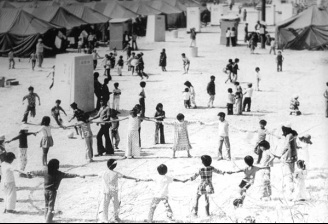
Refugee camps were set up for the "Boat People" by the United Nations High Commissioner of Refugees. It is estimated that the "United States accepted 823,000 refugees; Britain accepted 19,000; France accepted 96,000; Australia and Canada accepted 137,000 each, Germany and the United Kingdom accepted 19,000 each" (Trueman & Hoi). Some of the camps include: Koh Kra, Songkhla and Liem Sing in Thailand, Pulau Bidong and Pulau Tengah in Malaysia, Pulau Gaglang, Pulau Kuku and Pulau Buton in Indonesia, Palawan and Bataan in the Philippines, in Singapore, Hong Kong and in other countries open to the refugees (Tengah). There were many children in the refugee camps since primarily fathers or adult males were taken to the re-education camps while the mothers and children made up the majority of those who fled. Life in the refugee camps was a difficult adjustment for many of the children, but also allowed the opportunity to build a close sense of community as well as safety from the political danger in their homeland. The conditions were often cramped and strenuous, but most refugees were content with the hope of safety these camps offered them and their families. A former refugee living in a Hong Kong camp describes his childhood experience in the camp in saying: "Everything was new and different for me when I arrived, and I had to adapt to the climate, culture, language, food as well as people" (Mac). Many camps offered cultural classes teaching the new native languages in the hopes of integrating them into the countries culture outside of the camps (UN News Centre). However, not all countries were accepting of the Vietnamese refugees. Some areas rejected the refugees and towed the "Boat People" back out to sea resulting in death due to lack of food or capsizing. Other countries could only accept a limited number of refugees based on their population capacities.
"Re-Education Camps"
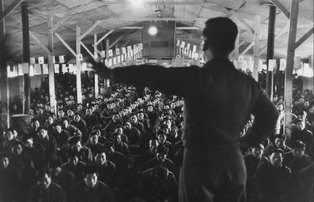
June of 1975, the Communist Northern Vietnamese forces ordered hundreds of thousands of Southern Vietnamese to forcibly participate in “re-education”. There were over 1 million people forced into the re-education camps, 165,000 of which resulted in their death (Trueman 1). There were about 150 re-education camps built after the Fall of Saigon (Butler). The Northern Vietnamese captured former regime, doctors, clergy, artists, poets, teachers, political leaders, and government workers and placed them into re-education camps (Denney). Many of these people are still in those camps. The Northern regime sought to integrate and indoctrinate their conquered Southern Vietnamese enemies into the newly established Communist society. They viewed it as an act of mercy, and alternative option for death or life imprisonment. The re-education camps were an act of revenge that greatly oppressed hundreds of thousands of Vietnamese individuals. The three types of re-education camps included: short term, long term and permanent incarceration (Mongabay). The process consisted of eight hours of manual labor a day, two half days per week for political study, and cultural classes nightly (Denney). Most camps were located in the jungle or secluded areas. Some of the conditions of these camps included dangerous labor, wide spread disease, lack of food, lack of medical care, physical abuse, and sometimes individuals were placed in airtight boxes left by the United States, put in underground cellars, added hours of labor, and reduced food rations as punishment. Many placed in the “conex” boxes passed out or died from the heat and lack of oxygen (Denney). In addition to this, all prisoners we forced to write confessions of their crimes and their lives. The intense pressure of this act drove many to mental insanity. Other forms of torture included being bound in different positions for long periods of time while being beaten such as the “Auto” in which the prisoner is tied by hands and feet and made to swing while being beaten(Denney).
Families were allowed to visit prisoners and bring food. Children often were brought along to visit their father and saw these cruelties first hand (Denney). The children whose parents were imprisoned in these re-education camps or chose not to flee were often left in the care of a single and struggling parent, or were orphaned by the death of their parents. Many of these children felt the heavy weight of these camps in ways that most people will never fully understand. Hung Huy Nguyen, a re-education camp prisoner tells his story and the impact it had on his wife and children (Butler). Nguyen made the decision to not flee out of respect to a sense of honor and duty. After being summoned for re-education, he urges his wife that if he has not returned within a month, for her to take up another husband in order to provide for their children. His orders his eldest daughter to act as a second mother to her siblings while he is away (Butler). These children undoubtedly had many obstacles during the absence of their father.
Families were allowed to visit prisoners and bring food. Children often were brought along to visit their father and saw these cruelties first hand (Denney). The children whose parents were imprisoned in these re-education camps or chose not to flee were often left in the care of a single and struggling parent, or were orphaned by the death of their parents. Many of these children felt the heavy weight of these camps in ways that most people will never fully understand. Hung Huy Nguyen, a re-education camp prisoner tells his story and the impact it had on his wife and children (Butler). Nguyen made the decision to not flee out of respect to a sense of honor and duty. After being summoned for re-education, he urges his wife that if he has not returned within a month, for her to take up another husband in order to provide for their children. His orders his eldest daughter to act as a second mother to her siblings while he is away (Butler). These children undoubtedly had many obstacles during the absence of their father.
"Operation Baby-Lift"
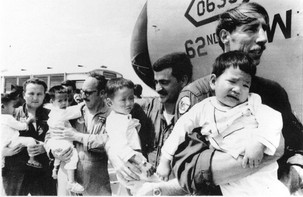
As the North Vietnamese forces were advancing into South Vietnam and the pending danger for thousands of Vietnamese orphans was increasing, President Gerald R. Ford ordered their evacuation through a $2 million effort called “Operation Baby-Lift” (Nguyen). A little over 3,000 Vietnamese orphans were airlifted and flown to safer countries on April 3, 1975, just a few weeks before the Fall of Saigon (Nguyen). About 2,700 of these orphans became child refugees in the United States of America. The remaining children were taken all over the world. Many were only infants; others were young children who were orphaned by American soldiers who had recently withdrawn. Sadly, one flight tragically crashed into a rice paddy resulting in the death of 154 children along with the adult volunteers (Nguyen). The child refugees were adopted to families and given citizenship of their new countries. These children were submerged into unfamiliar cultures, with unfamiliar faces, and unfamiliar languages.
For Operation Baby-Lift Video:
|
To Visit Operation Baby-Lift Website:
|
AFTERMATH OF CONFLICT
Effect on Re-Education Prisoners
There were deep effects that re-education programs had, on not only the political structure but also on the individual prisoners that have left them with lasting scars to this day. Many of these former prisoners experienced such traumatizing events in these camps that they now face great mental and emotional difficulties. It is reported that 34,641 former prisoners and 128,068 of their relatives fled to America after being released from the re-education camps (Phan). Many of these former prisoners experience serious sleep disorders such as waking from their sleep by haunting images, rattling nightmares of their pasts, and sleep walking (Phan). There is little personal stories and interviews in circulation due to the former prisoners' anxieties of how speaking out could potentially put their loved ones still living in Vietnam in danger. Some will speak out anonymously, but still experience a deep sense of fear in telling their stories. Others who have spoken out later regret it because of this overwhelming sense of anxiety and fear or because telling the memories becomes too difficult to handle. Many have admitted to feelings of a lack of resolution or healing because of their inability to speak their pasts (Phan). In addition to the emotional and mental damage these camps have cause, many second and third generations would have gaps in their family histories due to the loss of relatives in these camps. These camps ripped apart families, and greatly shifted Vietnamese family structures leaving children living full childhoods without the presence of a parent.
Effect on Refugees & Boat People
The aftermath effects not only impacted those who first hand experienced the conflict, but also greatly affected the lives of second and third generations. One particular second generation man retells his father’s story who
tried unsuccessfully to escape along with his eight siblings seven times and was jailed twice.
Finally his father managed to escape in a small boat of 50 other people, stayed in a
refugee camp for 9 months before being sponsored to move to Australia, where
he, his wife, children and grandchildren still live today. The second generation son describes
the effect his father’s escape had on the future generations in
saying: “At the moment, my children like living in Sydney and they have a very
good school too. I feel very lucky that my family is living here and the
education is very good for my children” (Thanh
Loc). The second generation son states that he and his children place a great level of importance on learning Vietnamese in an attempt to reconnect to the past (Thanh Loc). Many others refugees that gained citizenship fully submerged
their lives into their new culture, and putting the Vietnamese culture behind them. Dustin Nguyen, a popular TV actor and
survivor of the Fall of Saigon describe the cultural struggle that many of the
child refugees faced when establishing new lives in an unfamiliar culture: "For
most Asian-American kids, there's a lot of pressure to live the old way, the
way your parents would like you to live. They see what I do as selfishness"
(Vespa). Other refugees have returned permanently or temporarily, and had to uproot their lives and adjust to a culture all over again. Those who have returned, we openly welcomed by the Vietnamese people and government.
Effect on Operation Baby-Lift Children
Since the child refugees part of the Operation Baby-Lift
were all orphans, many have since then struggled with coming to terms with
their past and establishing a sense of identity. Viktoria Cowley, one of those babies, tells the
effect of the Operation Baby-lift on her own life to BBC Radio now as an adult. She doesn’t know
much about her story. Her identity is solely founded in the little bits of
information that she was given by others, including that her father was a
United States soldier, and her mother had too many children already to care for
and therefore placed her in an orphanage (Cowley). Cowley tells BBC Radio that since she does not
know where to begin in the process of seeking out her lost family in Vietnam, she instead finds comfort in
connecting with other Baby-Liftees who share her experience. She has already tracked
down 15 other airlift babies (Cowley). Many others part of operation Baby-Lift have since then struggled with identity. A documentary was made in 2009, that interviewed some of these babies, now in their adulthood, including: Robert "Bert" Ballard and his wife Sarah, Dan Bischoff, Chris and Kelly Brownlee, Tim Buchanan, Tiffany Goodson, Jane Hopkins, Brent Kurkoski, Lyly Koenig, Tara Leaman, Jennifer Noone, Khanh Oehlke, Canh Oxelson, Jared Rehberg, Mark Slavik, DC Wolfe, Lucas Young and Jim Zimmerly (Nguyen). The more that these adoptees connect and share their stories with each other, the more healing they provide themselves and each other.
To Listen to the Full BBC Radio Interview with Viktoria Cowley:
|
Children of the Dust
Most never knew their fathers. Many were abandoned by their mothers at the gates of orphanages. Some were discarded in garbage cans.Schoolmates taunted and pummeled them and mocked the features that gave them the face of the enemy—round blue eyes and light skin, or dark skin and tight curly hair if their soldier-dads were African-Americans. Their destiny was to become waifs and beggars, living in the streets and parks of South Vietnam's cities, sustained by a single dream: to get to America and find their fathers. But neither America nor Vietnam wanted the kids known as Amerasians and commonly dismissed by the Vietnamese as "children of the dust"—as insignificant as a speck to be brushed aside. "The care and welfare of these unfortunate children...has never been and is not now considered an area of government responsibility," the U.S. Defense Department said in a 1970 statement. "Our society does not need these bad elements," the Vietnamese director of social welfare in Ho Chi Minh City (formerly Saigon) said a decade later . No one knows how many Amerasians were born—and ultimately left behind in Vietnam—during the decade-long war that ended in 1975. Amerasians were vulnerable to drugs, became gang members and ended up in jail. As many as half remained illiterate or semi-illiterate in both Vietnamese and English and never became U.S. citizens. The mainstream Vietnamese-American population looked down on them, assuming that their mothers were prostitutes—which was sometimes the case, though many of the children were products of longer-term, loving relationships, including marriages. Mention Amerasians and people would roll their eyes and recite an old saying in Vietnam: Children without a father are like a home without a roof. Amerasians had 30 years of trauma, and you can't just turn that around in a short period of time or undo what happened to them in Vietnam. It wasn't long before unofficial reports began to detail mental-health problems in the Amerasian community. "We were hearing stories about suicides, deep-rooted depression, an inability to adjust to foster homes," says Fred Bemak, a professor at George Mason University who specializes in refugee mental-health issues and was enlisted by the National Institute for Mental Health to determine what had gone wrong. "We'd never seen anything like this with any refugee group" (City & Lamb).
CURRENT STATE OF AFFAIRS
Current Political & Economic Conditions
Since April 25, 1976, the former "Democratic Republic of Vietnam" has been referred to as the "Socialist Republic of Vietnam" (Vietnam Embassy). Within the ten years immediately following the Vietnam War, the economy took a major dive, causing a serious economic crisis (Vietnam Embassy). This economic crisis made the already difficult conditions even more amplified. After suffering from this economic crisis the Communist Party set in place economic reforms resulting in the country currently standing as the second largest rice exporter in the world, boosting it's economy (Vietnam Embassy). Those who have returned have commented that "Vietnam has changed tremendously and joined in the global markets and entrepreneur" (Mac).
The government structure is centered around the working class, and serves their interests first. The country places emphasis on giving the decisions and power to the people through the use of multiple levels and branches of "People's Courts". Their laws are solely regulated by the Communist Party of Vietnam. The "National Assembly" consists of the highest level of a representative body who conduct the power of the States, legislature, and major national decisions (Vietnam Embassy). The National Assembly also is responsible for electing the State President to be the Head of State (Vietnam Embassy). Although relations with Vietnam have more recently become cooperative and flourishing, there are still "explosive remnants of War" and political unrest (USA Embassy). There are still some levels of repression of former South Vietnam resistance, and foreign visitors are required to register with the police regularly (Vietnam Embassy).
The government structure is centered around the working class, and serves their interests first. The country places emphasis on giving the decisions and power to the people through the use of multiple levels and branches of "People's Courts". Their laws are solely regulated by the Communist Party of Vietnam. The "National Assembly" consists of the highest level of a representative body who conduct the power of the States, legislature, and major national decisions (Vietnam Embassy). The National Assembly also is responsible for electing the State President to be the Head of State (Vietnam Embassy). Although relations with Vietnam have more recently become cooperative and flourishing, there are still "explosive remnants of War" and political unrest (USA Embassy). There are still some levels of repression of former South Vietnam resistance, and foreign visitors are required to register with the police regularly (Vietnam Embassy).
Current Status of Refugees & Refugee Camps
Since the massive fleeing and evacuation of Vietnam after the withdrawal of the U.S. troops, and the establishment of refugee camps by the United Nations High Commissioner of Refugees, many of the camps have since closed or consolidated (Hoi). The United Nations reported in 2005, that the last and final "Boat Person" had left Malaysia (UN News Centre). Doan Van Viet escaped the turmoil in a boat at age 22, and found refuge in the Malaysian Refugee camp of Pulau Bidong (UN News Centre). When this camp was closed in 1990, he transferred to another camp, Sungai Bes, which closed six years later leaving him with the only option of blending his life into Malaysia outside of the familiar life of the refugee camps (UN News Centre). This is just one out of the many similar stories. Many of the refugees that left Vietnam seeking safety during the conflict, have gone in different directions since then. Some remain in refugee camps, while others have either sought citizenship of their host country, making it their permanent home or have opted to return to Vietnam years later. The United Nations High Commissioner of Refugees has assisted in the settlement of refugees into other countries or assisted them in the process of repatriation-- the settling of refugees into life outside the camps. The United Nations reports that 9,000 of the 240,000 Vietnamese refugees in Malaysia have opted to return to Vietnam (UN News Centre). In total, the United Nations aided through sponsorship 109,000 Vietnamese boat people to return to Vietnam since the original conflict (UNHCR Refugees By Numbers). The remaining refugees still living in refugee camps around the world total about 317,000, not including those who have left the camps voluntarily or forcibly to gained citizenship in their new countries (UNHCR Refugees By Numbers). There are still a lot of displaced persons due to the conflict, even many years later. Children are scattered among all of these statistics and numbers.
Current Status of Re-Education Camps & Prisoners
Camps were still operating up until the late 1980s. The camps have since closed and prison survivors have all been released. The Hanoi government refuse to comment on the re-education camps but have released the statement: ""After the southern part of Vietnam was liberated, those people who had worked for and cooperated with the former government presented themselves to the new government. Thanks to the policy of humanity, clemency and national reconciliation of the State of Vietnam, these people were not punished" (Phan). Although the prisoners have been released and the camps have closed, there is clearly a sense of refusal to accept responsibility and acknowledge the cruelty that took place in these camps. The government's refusal to acknowledge their fault leaves many released former prisoners feeling that they they are social outcasts who deserved the imprisonment, or it has created private anger and bitterness towards the government.
GLOSSARY OF TERMS
Asylum- Protection granted by a nation to someone who has left their native country as a political refugee. Shelter or protection from danger (Merriam-Webster).
Boat People- Refugees fleeing by boat. Originally referred to the Vietnamese in 1975 who were fleeing their country by sea during political conflict between North and South Vietnam (Merriam- Webster). Dust Child- the mixed-race son of an American soldier and a Vietnamese mother. Fall of Saigon- April 30, 1975 the capital city of South Vietnam, Saigon was captured by North Vietnam. The new acting president surrenders South Vietnam to North Vietnam (Dictionary). Hanoi- The capital of North Vietnam (Merriam-Webster). Nguyen Van Thien-The former President of South Vietnam who resigned on April 21, 1975 to flee to Taiwan after nominating his vice president as successor This quickly led to the Fall of Saigon (Dictionary). Operation Babylift- A mass evacuation of children from South Vietnam to the United States and other countries (including Australia, France, and Canada) at the end of the Vietnam War between April 3-26, 1975 in an effort to protect them from the advancing forces before the Fall of Saigon (Dictionary). Operation Frequent Wind- Massive evacuation of the United States embassy in Saigon that airlifted U.S. government personnel, and potential South Vietnamese targets. Thousands of South Vietnamese crowded the gates of the embassy vainly waiting for evaluation (Dictionary). Re-EducationCamps- North Vietnam prison camps in which thousands of former military officers, government workers, and clergy from South Vietnam were imprisoned and forcibly exposed to repression and indoctrination as an act of revenge following the 1975 Fall of Saigon (Dictionary). Tet Offensive- An offensive launched in January–February 1968 by the Vietcong and the North Vietnamese army. Timed to coincide with the first day of the Tet (Vietnamese New Year), it was a surprise attack on South Vietnamese cities, notably Saigon. Although repulsed after initial successes, the attack shook US confidence and hastened the withdrawal of its forces (Dictionary). Viet Cong- A member of the communist guerrilla movement in Vietnam that fought the South Vietnamese government forces between 1954–75 with the support of the North Vietnamese army and opposed the South Vietnamese and US forces in the Vietnam War. Also known as the National Liberation Front or NLF (Merriam-Webster). Viet Minha- Communist national independence coalition formed in 1941 seeking independence for Vietnam from French Empire. Opposed South Vietnam and the United States in Vietnam War (Dictionary). Vietnamization- A strategy introduced by President Richard Nixon which intended to end the involvement of Americas in the Vietnam War through the gradual withdrawal of the U.S. forces and shifting the responsibility to the South Vietnamese (Dictionary). |
RELEVANT CHILDREN'S LITERATURE BIBLIOGRAPHIES
"A Million Shades of Gray"

Author: Cynthia Kadohata
Bibliography: Kadohata, Cynthia. A Million Shades of Gray. New York: Atheneum for Young Readers, 2010. Print.
Relevance: A story of a young boy and his elephant who escape into the jungle when the Vietcong attack his village immediately after the Vietnam War.
Bibliography: Kadohata, Cynthia. A Million Shades of Gray. New York: Atheneum for Young Readers, 2010. Print.
Relevance: A story of a young boy and his elephant who escape into the jungle when the Vietcong attack his village immediately after the Vietnam War.
"Dan Thuy's New Life in America"
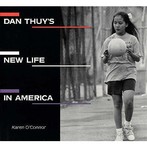
Author: Karen O'Connor
Bibliography: O'Connor, Karen. Dan Thuy's New Life in America. Minneapolis: Lerner Publications, 1992. Print.
Relevance: A photo essay that follows a family adjusting to their lives after spending three years in refugee camps in Cambodia, Thailand then American following the conflict in Vietnam.
Bibliography: O'Connor, Karen. Dan Thuy's New Life in America. Minneapolis: Lerner Publications, 1992. Print.
Relevance: A photo essay that follows a family adjusting to their lives after spending three years in refugee camps in Cambodia, Thailand then American following the conflict in Vietnam.
"Dust of Life: 1980 History's Children"
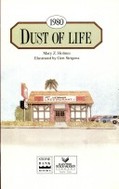
Author: Mary Z. Holmes
Bibliography: Holmes, Mary Z., and Geri K. Strigenz. Dust of Life: 1980. Austin, TX: Raintree Steck-Vaughn, 1992. Print.
Relevance: A young girl living in California welcomes her cousin who is a Vietnamese refugee and attempts to help her cope with her traumatic experiences in Vietnam.
Bibliography: Holmes, Mary Z., and Geri K. Strigenz. Dust of Life: 1980. Austin, TX: Raintree Steck-Vaughn, 1992. Print.
Relevance: A young girl living in California welcomes her cousin who is a Vietnamese refugee and attempts to help her cope with her traumatic experiences in Vietnam.
"Escape from Saigon: How a Vietnam War Orphan Became an American Boy"
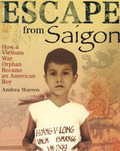
Author: Andrea Warren
Bibliography: Warren, Andrea. Escape from Saigon: A Vietnam War Orphan Becomes an American Boy. New York: Farrar, Straus and Giroux, 2004. Print.
Relevance: A true account of an Amerasian boy orphaned by the Vietnam War. He escapes the Fall of Saigon through "Operation Baby-Lift". It documents his childhood as a refugee and follows him into his adulthood as he travels back to Vietnam to come to terms with his childhood past. The book provides a pretext describing the war and the children caught in the middle of it.
Bibliography: Warren, Andrea. Escape from Saigon: A Vietnam War Orphan Becomes an American Boy. New York: Farrar, Straus and Giroux, 2004. Print.
Relevance: A true account of an Amerasian boy orphaned by the Vietnam War. He escapes the Fall of Saigon through "Operation Baby-Lift". It documents his childhood as a refugee and follows him into his adulthood as he travels back to Vietnam to come to terms with his childhood past. The book provides a pretext describing the war and the children caught in the middle of it.
"Journey Home"
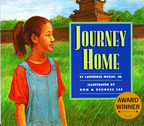
Author: Lawrence McKay
Bibliography: McKay, Lawrence, Dom Lee, and Keunhee Lee. Journey Home. New York: Lee & Low, 1998. Print.
Relevance: A story of a young girl traveling to Vietnam to seek out the family who gave her up for adoption during the war. In Vietnam, she visits orphanages until she eventually finds a photograph and an old man who tells her the story of her past.
Bibliography: McKay, Lawrence, Dom Lee, and Keunhee Lee. Journey Home. New York: Lee & Low, 1998. Print.
Relevance: A story of a young girl traveling to Vietnam to seek out the family who gave her up for adoption during the war. In Vietnam, she visits orphanages until she eventually finds a photograph and an old man who tells her the story of her past.
"Sweet Dried Apples: A Vietnamese Wartime Childhood"
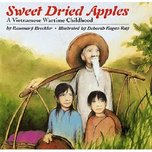
Author: Rosemary Breckler
Bibliography: Breckler, Rosemary, and Deborah Kogan Ray. Sweet Dried Apples: A Vietnamese Wartime Childhood. Boston: Houghton Mifflin, 1996. Print.
Relevance: A portrait of a childhood that was devastated by the aftermath of the Vietnam War.
Bibliography: Breckler, Rosemary, and Deborah Kogan Ray. Sweet Dried Apples: A Vietnamese Wartime Childhood. Boston: Houghton Mifflin, 1996. Print.
Relevance: A portrait of a childhood that was devastated by the aftermath of the Vietnam War.
"The Lotus Seed"
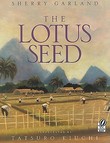
Author: Sherry Garland
Bibliography: Garland, Sherry, and Tatsuro Kiuchi. The Lotus Seed. San Diego: Harcourt Brace Jovanovich, 1993. Print.
Relevance: A story of a young Vietnamese refugee girl who's living in America. She brought a lotus seed to her new home in order to remember her homeland and past.
Bibliography: Garland, Sherry, and Tatsuro Kiuchi. The Lotus Seed. San Diego: Harcourt Brace Jovanovich, 1993. Print.
Relevance: A story of a young Vietnamese refugee girl who's living in America. She brought a lotus seed to her new home in order to remember her homeland and past.
WORKS CITED
- Butler, Rhett A. "Vietnam-Re-education Camps." Vietnam-Re-education Camps. 2010. Web. 21 Sept. 2012. <http://www.mongabay.com/history/vietnam
- City, KAY JOHNSON Ho Chi Minh. "Children of the Dust." Time. Time, 13 May 2002. Web. 25 Sept. 2012. <http://www.time.com/time/ magazine /article /0,9171,237115,00.html>.
- Cowley, Viktoria. "BBC Radio Scotland Interview - Operation Babylift." World News. BBC Radio, 19 Nov. 2009. Web. 21 Sept. 2012. <http://wn.com /bbc_radio_scotland_interview_-_operation_babylift/video-details>.
- Denney, Steven, and Ginetta Sagan. "Re-Education in Unliberated Vietnam: Loneliness, Suffering and Death." Open Computing Facility. Berkeley University, n.d. Web. 20 Sept. 2012. <http://www.ocf.berkeley.edu/~sdenney/Vietnam-Reeducation-Camps-1982>.
- "Dictionary." Dictionary.com. Dictionary.com, n.d. Web. 21 Sept. 2012. <http://dictionary.reference.com/>.
- Phan,Tran and Anh Do. "Dart Center for Journalism and Trauma." Camp Z30-D: The Survivors. Dart Center, 1 Mar. 2009. Web. 21 Sept. 2012. <http://dartcenter.org/content/camp-z30-d-survivors-0>.
- Hoi, Trinh. "Horrible Statistics of Thai Pirates vs Vietnamese Refugees." Horrible Statistics of Thai Pirates vs Vietnamese Refugees. Vietka, 2005. Web. 20 Sept. 2012. <http://www.vietka.com/Vietnamese_Boat_People/HorribleStatistics.htm>.
- Hoi, Trinh. "Vietnamese Boat People - Refugee Camps." Vietnamese Boat People - Refugee Camps. Vietka, 2005. Web. 20 Sept. 2012. http://www.vietka.com/refugee_camps.htm.
- Lamb, David. "Smithsonian.com." Smithsonian Magazine. Smithsonian, June 2009. Web. 25 Sept. 2012. <http://www.smithsonianmag.com/people-places /Children-of-the-Dust.html?c=y>.
- "Last of Vietnamese Boat People in Malaysia Returns Home, UN Agency Reports." UN News Centre. The United Nations, 30 Aug. 2005. Web. 21 Sept. 2012. <http://www.un.org/apps/news/story.asp?NewsID=15600>.
- Mac, T. K. "Vietnamese Refugee Expresses Gratitude for Vietnam War Veterans." Kitsap Sun. Kitsap Sun, 5 Nov. 2010. Web. 21 Sept. 2012. <http://www.kitsapsun.com/news/2010/nov/05/vietnamese-refugee-expresses-gratitude-for-vietnam/>.
- "Merriam-Webster Dictionary". Merriam-Webster Incorporated, 2012. Web. 21 Sept. 2012. <http://www.merriam-webster.com/>.
- Nguyen Lee, Tammy. "Operation Babylift History." Operation Babylift. Against The Grain Productions, 2006. Web. 20 Sept. 2012.
- Phan,Tran and Anh Do. "Dart Center for Journalism and Trauma." Camp Z30-D: The Survivors. Dart Center, 1 Mar. 2009. Web. 21 Sept. 2012. <http://dartcenter.org/content/camp-z30-d-survivors-0>.
- "Refugees by Numbers." United Nations Search. The United Nations, n.d. Web. 21 Sept. 2012. http://www.un.org/cyberschoolbus/briefing/refugees /refugees.pdf
- Rosenberg, Jennifer. "Vietnam War." About.com 20th Century History. N.p., n.d. Web. 25 Sept. 2012. <http://history1900s.about.com/od/vietnamwar /a/vietnamwar.htm>.
- Tengah. "Remembering the Vietnamese Exodus." Refugee Camps. RefugeeCamps.info, 2012. Web. 20 Sept. 2012. <http://www.refugeecamps.net /Update.html>.
- Thanh Loc, Vuong. "A Boatperson's Story of Deprivation and Determination to Find Another Homeland." A Boatperson's Story of Deprivation and Determination to Find Another Homeland. Vietka, n.d. Web. 21 Sept. 2012. <http://www.vietka.com/Vietnamese_Boat_People/AnotherHomeland.htm>.
- Trueman, Chris. "Vietnamese Boat People." Vietnamese Boat People. History Learning Site, 2000. Web. Sept.18 2012. <http://www.historylearningsite.co.uk
- "USA Embassy in Socialist Republic of Vietnam." Embassy of the United States. United States Department of State, n.d. Web. 21 Sept. 2012. <http://vietnamembassy-usa.org/>.
- Vespa, Mary, and Michael Alexander. "A Survivor of the Fall of Saigon, 21 Jump Street's Dustin Nguyen Relives the Ordeal on Tv." People.com. People Magazine, 25 Apr. 1988. Web. 21 Sept. 2012. http://www.people.com/people/archive/article/0,,20098795,00.html.
- "Vietnamization." History.com. A&E Television Networks, n.d. Web. 25 Sept. 2012. <http://www.history.com/topics/vietnamization>.
- "Vietnam Embassy in the United States." Embassy of the United States. U.S. Department of State, 1 Aug. 2012. Web. 21 Sept. 2012. <http://vietnam.usembassy.gov/usvnrelations.html>.
IMAGES CITED
- Heading Photo: http://www.vietwaytravel.info/en/vietnam/vietnam-war.html
- Vietnam Map: http://www.ciphersbyritter.com/NAM/NAM.HTM
- Ngo Dinh Diem Photo: http://www.vietnamwiki.net/Vietnam_general-History-Milestones_in_Vietnam_history-P123
- Ho Chi Minh Photo: http://tinhamburg.blogspot.com/2012/04/ho-chi-minh-mot-sat-thu.html
- Pre-Conflict Main Photo: http://www.fototazo.com/2012_04_01_archive.html
- Boat People Main Photo: http://www.dailymail.co.uk/news/article-1239285/The-30-year-papers-How-Maggie-handbagged-world-just-8-months.html
- Boat People Left Photo: http://minnesota.publicradio.org/display/web/2009/11/16/vietnamese-refugees/
- Boat People Center Photo: http://www.historylearningsite.co.uk/vietnam_boat_people.htm
- Boat People Right Photo: http://www.migrationheritage.nsw.gov.au/exhibitions/goldandsilver/journey/pham.shtml
- Refugee Camp Main Photo: http://www.latimes.com/news/local/la-me-vietnamese-camp-pictures,0,6557534.photogallery
- Re-Education Camp Main Photo: http://todayspictures.slate.com/20080417/
- Re-Education Camp Left Photo: http://thunder510.fotki.com/images_of_vietnam/second_indochina_war/re-education_camps/reedcamp002.html
- Re-Education Camp Center Photo: http://www.vnch-patriot.co.cc/2009/11/vietnam-after-1975-true-story-of.html
- Re-Education Camp Right Photo: http://eyedrd.org/2011/12/vietnam-reopens-re-education-camps-for-patriots-and-activists-ms-bui-hang-is-a-new-student.html
- Operation Baby-Lift Main Photo: http://lakeville.patch.com/articles/dakota-county-vietnam-veterans-lakeville-s-bruce-mcrae-airforce-reserve-with-operation-babylift-1d8cb427#photo-8418843
- Operation Baby-Lift Left Photo: http://www.dagiornoanotte.com/page/2
- Operation Baby-Lift Center Photo: http://www.adoptvietnam.org/adoption/babylift-thieman.html
- Operation Baby-Lift Right Photo: http://article.wn.com/view/2012/07/27/Vietnamese_community_not_celebrating_home_countrys_appearanc/
- Operation Baby-Lift Video Link: http://www.youtube.com/watch?v=w3IGZAHHMdE
- Operation Baby-Lift Movie Website: http://www.thebabylift.com/
- Glossary Photo One: http://www.flickriver.com/photos/13476480@N07/5163282918/
- Glossary Photo Two: http://www.businessinsider.com/horst-faas-photos-war-vietnam-congo-2012-5?op=1
- Glossary Photo Three: http://members.tripod.com/atif_nazir/unforget_photos.htm
- Glossary Photo Four: http://www.allposters.com/-sp/A-South-Vietnamese-Father-Carries-His-Son-and-a-Bag-of-Household-Possessions-Posters_i3710953_.htm
- Million Shades of Gray Photo: http://sdsubookreviews.blogspot.com/2012/08/a-million-shades-of-gray-by-cynthia.html
- Dan Thuy's New Life in America Photo: http://www.betterworldbooks.com/dan-thuy-s-new-life-in-america-id-0822525550.aspx
- Dust of Life 1980 History's Children Photo: http://books.google.com/books/about/Dust_of_life.html?id=4h_68S8G9rkC
- Escape From Saigon Photo: http://www.needtoreadbookclub.org/April%20Books%20Year%202.htm
- Journey Home Photo: http://www.theafricanamericanbookcompany.com/products_new.php?page=32
- Sweet Dried Apples Photo: http://www.betterworldbooks.com/sweet-dried-apples-cl-id-039573570X.aspx
- The Lotus Seed Photo: http://www.betterworldbooks.com/the-lotus-seed-id-0152014837.aspx
